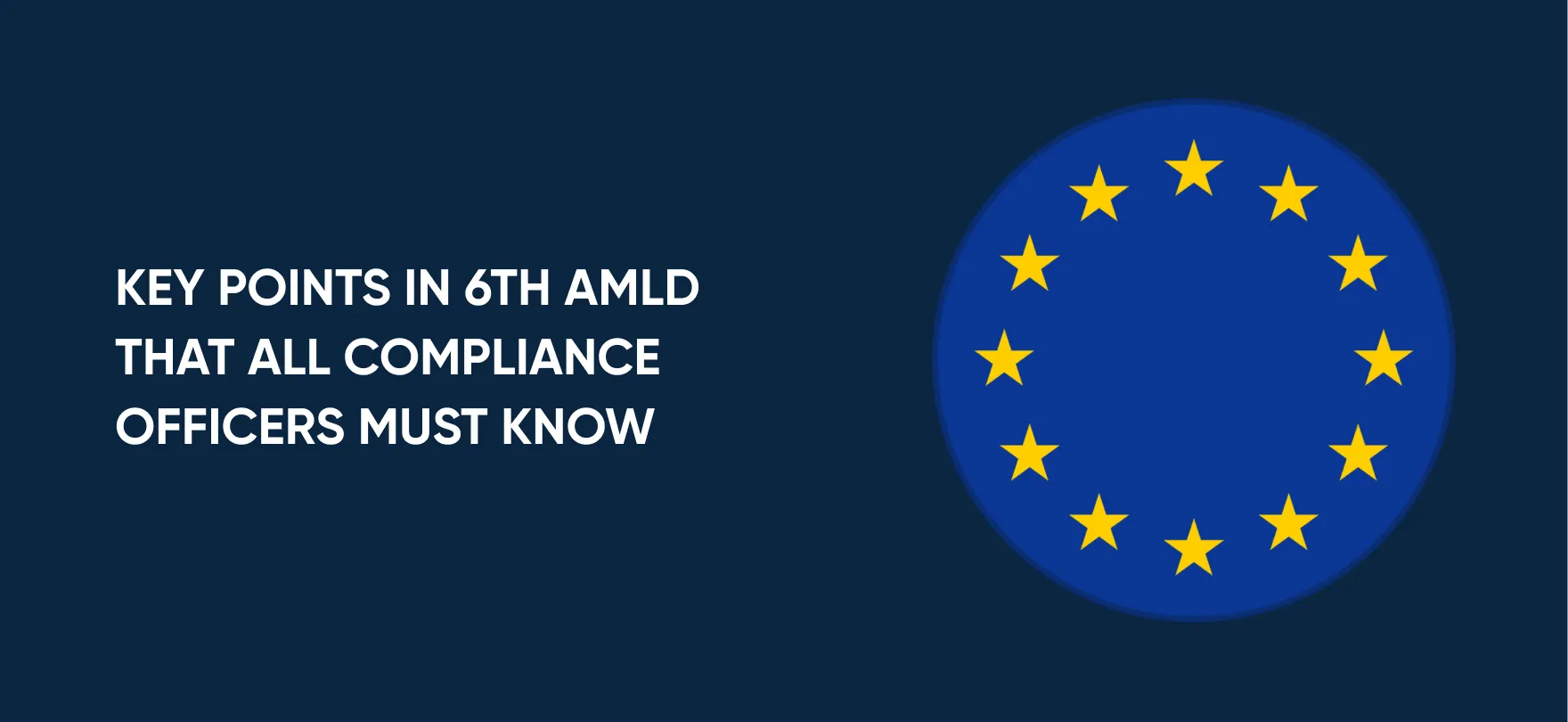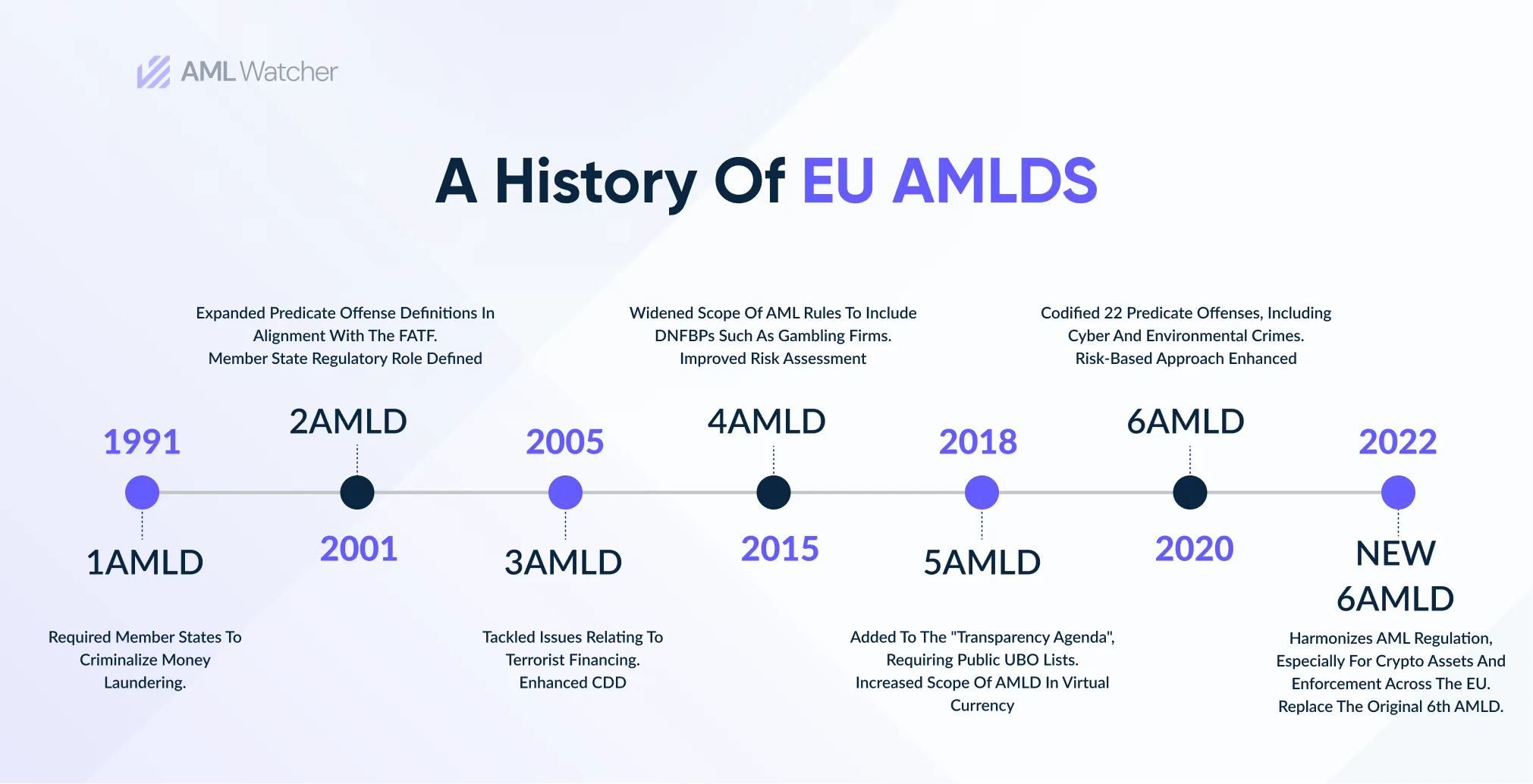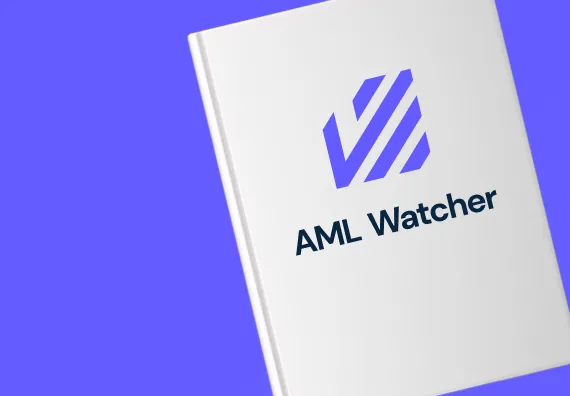
Key Points in 6th AMLD That All Compliance Officers Must Know
Do you know that every year, suspicious transactions of between €117 billion and €210 billion are facilitated by the European financial system?
It won’t surprise you that global money laundering activities stand for €715 billion and €1.87 trillion, annually, and the numbers are rising with each passing hour.
This concerning situation has been shown in The Europol Report 2023, where findings indicate that 80% of criminal and fraudster networks that operate within the EU take advantage of multiple legal company structures and about 70% of them utilize money laundering and illegal earnings as a way of financing their operations and convert this dirty money into the legal one.
With financial modernization, the strategies used by criminals are also modernizing.
To counter this, the 6th Anti-Money Laundering Directive (6AMLD) came into force and transformed the legal strategies and compliance rules to deal with financial crimes in the EU and businesses operating in the bloc.
The main focus of the 6AMLD is on the elaboration of legal loopholes and lax rules used by financial criminals. This includes cyber offenses, UBOs, cross-border corporations, and environmental crime. The 6AMLD also covers corporations and their coverage of precedent misdeeds.
This directive is not merely a legal change but a weapon to protect the credibility of the financial systems and boost cross-border trades by combating the complex AML checks.
Before proceeding further, let’s get a quick view of the background of EU AML Directives.
History of European Union’s AML Directives
The European Union’s Anti Money Laundering Directives are released periodically to update the collective stance of the EU on money laundering and terrorism financing risks.
Whenever the European Parliament comes up with new Anti Money Laundering Directives, regulations, or laws there is always a comprehending and implementation phase whereby the EU’s member-states are expected to incorporate that money laundering directive or regulation into a country’s specific laws and obligate every financial sector, businesses operating cross border and domestic banks to stay compliant with it.
Decades Journey to Stop Financial Crimes
Did you know that the history of global legislation against money laundering and related predicate crimes was first introduced globally in 1989 to stop the flow of illegal money from organized drug cartels?
Read about the 3 Decade Journey Of EU Anti Money Laundering AML Directives.
The EU’s anti-money laundering and terrorist support framework is revised and reinforced with strict and refined regulation introduced with the Sixth Money Laundering Directive (AMLD), which utilizes the regulatory basis of the previous five EU directives.
The first EU AMLD was implemented in 1991 as a result of global awareness of the money generated, transferred, and exchanged by the drug trade in the legal economy. The next set of AML Directives referred to as 2AMLD (enforced in 2001), 3AMLD (approved in 2006), 4AMLD (introduced in 2017), and 5AMLD (implemented in 2018), have additional goals and more complex requirements for the framework of law that each member state is required to apply through its legal system.
Sixth Anti-Money Laundering Directive: A Significant Advance in the Fight Against Financial Crime
In the EU’s battle against financial crime and money laundering operations, the 6th Anti-Money Laundering Directive (6AMLD) represents a significant breakthrough, where authorities took a strong stance to implement more strict regulations.
This framework is still being developed. Adopted on December 3, 2020, and effective from June 3, 2021, this directive focuses on the previous EU AML Directives’ advancements while laying down additional strict measures to improve AML systems within member states.
Businesses carrying out their activities in Europe and the multinationals operating in other parts of the globe must ensure that their due diligence and continuous risk monitoring procedures correspond with the desired standards to avoid legal, financial, reputational, and strategic losses.
The objectives of the 6th AML Directive include strengthening the member’s financial institutions and authorities’ capacity to combat money laundering and terrorism financing since it broadens existing legislation without majorly changing the criminal law across the EU and enhances the collaboration between the Member States.
Discover More About the 5th AML Directive
The EU’s Fifth AML Directive is an improved and stringent version of the Fourth AML Directive that came into force on January 10, 2020, through the EU blocs.
The 5th AML Directive focused the Industries and addressed gaps in the global financial system that the preceding AML Directives did not specifically address.
What Are The Key Highlights or Main Changes of 6AMLD?
Compliance officers need to know how their enterprise’s policies, procedures, and patterns have changed in light of 6AMLD’s legal acceptance and incorporation throughout EU member states, as well as how to handle these additional compliance-related tasks.
The main changes are:
Greater Regulatory Harmonization
One rule to rule them all—6AMLD’s unified regulations means there are no longer any disparities that criminals can take advantage of within the European Union.
All EU nations and business communities operating in the EU are required to adhere to the one standard definition of money laundering published by 6AMLD.
Legal inconsistencies and anomalies in domestic legislation, as well as money laundering methods that make use of recently emerging technologies or legal loopholes, are to be reduced or eliminated through harmonization.
So, Compliance officers should consider revisiting personal knowledge of the law in their jurisdiction. In addition, they must ensure that their internal AML systems and policies are robust enough to manage the extra risk exposures and criminal activities resulting from the new definitions.
22 Predicate Offenses For Money Laundering
In addition to the acts that were stated about the harmonization of regulations, the European Union also provided a list of twenty-two money laundering offenses. These crimes include tax evasion, illicit trade, cryptocurrency fraud, drug trafficking, fraud, and human trafficking.
Two new predicate offenses were added to the list of 22 predicate offenses: increasing cybercrime and increased environmental crime. These additions could be seen as an evolution of the EU’s focus on emerging criminal concerns and changes in the legal profiles of its member states.
Enhanced Regulatory Scope
Imagine that cybercriminals and tax evaders were subject to the same monitoring as drug lords.
The 6th AML Directive expanded the definition of money laundering to include the new predicate charge of “aiding and abetting,” which pertains to the new offenses.
Accordingly, under 6AMLD, anyone who helps money launderers turn illicit profits into legitimate income streams faces serious charges of money laundering and will be held responsible for their conduct.
Put another way, the term “aiding and abetting” describes people or organizations that either proactively try to launder money or invite or support various criminals to do so.
Extension Of Criminal Liability
Companies can no longer hide behind employees—if your business is dirty, you’re in the spotlight.
First, the passing of the 6th AML Directive broadened the list of criminal activities linked to money laundering but also modified the method through which criminal responsibility is attributed to the offense.
Essential Knowledge Check
Although the United Kingdom has left the EU, and although it has intentionally decided not to transpose 6AMLD into its legal mechanism, the UK has already incorporated the directive’s regulation into its own legislation and restricted domestic businesses d to adhering to the terms of the directive as it contains.
Prior to 6 AMLD, money laundering offenses may only result in the liability of individual offenders. The latest legislation establishes criminal responsibility towards legal persons, meaning that companies may face consequences for transgressions carried out by their personnel.
In any case, if a company is found guilty of conducting money laundering will be subject to severe penalties, including significant fines, strict supervision orders, operational limitations, closed monitoring, and business suspensions.
This change highlights the importance that corporate criminal conduct is no more a concerning point of an individual employee only but it is for every management personnel.
Harsh Money Laundering Punishments
Thinking four years in prison is tough? Under the 6AMLD, that’s just the starting point.“
The EU regulators emphasize starting to more closely harmonize the money laundering sanctions among its member states by enacting the 6AMLD, which increased the minimum mandatory jail sentence for money laundering.
The minimum penalty for money laundering convictions was one year in prison before the introduction of the 6 AML directive; the new guidelines increased that minimum one year to four years in prison for money launderers.
About the new 6AMLD sentencing guidelines, the first one states that companies or businesses found guilty of money laundering may not be eligible for EU funding for public contracts and that offenders may face strict regulatory terms, like fines as a sentence.
Focused Dual Criminality
Linked by Crime, United by Law: EU Tackles Cross-Jurisdiction Money Laundering & Dual Criminality in Money Laundering”
This may be so since the crime of money laundering may have a feature of dual criminality. It is an act that is considered unlawful in a given jurisdiction before the proceeds are taken to another violating that other country’s laws.
On this matter, it approaches the issue of dual criminality since it provides accurate information of the jurisdictions regarding the exchange of information so that the linked criminal trials for the respective crimes in more than one Member State of the EU can be held.
By incorporating the 6AMLD’s dual criminality provisions, the EU member states are mandated to outlaw some of the predicate crimes regardless of the unlawful status in that country. Without any doubt, these crimes are drug trafficking, corruption, terrorism financing, organized criminal activity, and human trafficking.
It will allow the member states that are executing the case to work together to effectively regionalize legal procedures under one jurisdiction.
AML Check
This enhanced criminal liability through 6AMLD conveys a message that the European Union is prepared and eager to require major corporations, domestic business units, and financial institutions to assume greater accountability within its enforcement and monitoring framework and contribute to the worldwide battle against financial crime.
Adapting To 6AMLD By Obliged Entities
Since the law entered into operation, all EU banks, domestic businesses, and financial institutions have to follow its guidelines and adhere to 6AMLD. In practical terms, this means that to account for the modifications made to predicate offenses and criminal responsibility, compliance officers should review their present internal AML compliance solution.
The following are the crucial actions to consider:
- Defining money laundering under the 6th AML Directive and outlining the 22 predicate violations that are connected to money laundering within the company.
- Taking into account the criminal risk associated with possible money laundering charges, particularly those committed by management and senior staff.
- Customizing AML risk assessment processes aligning all contemporary risks to reduce maximum false positives and negatives.
- Making the right AI-based screening choices to ensure continued adherence to the 6AMLD.
- Compliance professionals need ongoing training to keep up with evolving anti-money laundering regulations globally.
6AMLD’s Emphasis On Screening Obligations
Firms must adjust the corresponding compliance screening services following the broader set of regulations that 6AMLD applies. For instance, they must increase customer due diligence to detect riskier consumers, accurate screening solutions to reduce maximum false positives, and many more. In this practical context, this means that firms need to carry out regular screening for customers at onboarding and throughout the customer lifecycle to be aware of any new AML risk exposure.
Recommendations for Complying With 6AMLD
Obligated firms are required to investigate any changes to the regulatory framework brought about by 6AMLD, including new predicate offenses that need to be investigated and new risk perspectives that the organization must be working on.
Check a detailed process to achieve AML compliance goals and undertake the essential customer screening requirements.
Now the point of concern is where to find a reliable and efficient screening solution provider that must align with 6AMLD regulations.
Continue reading this article because we’ll introduce a highly credible and efficient AML screening solution with its extensive screening coverages aligned with all EU AMLD.
Streamlining Screening Solutions With AML Watcher: Aligning With 6AMLD
AML Watcher stands as a powerful partner in the fight against financial crime, especially the adherence to the 6th AML Directive and staying compliant. AML Watcher creates operational ease by offering:
1. Detailed Risk Analysis And Adaptable Customer Risk
Advanced algorithms backed by AML Watcher’s solution offer thorough risk assessments which are essential in defining the focus on risky subjects as per the new dimensions of 6AMLD that include cybercrime and environmental offenses.
The customization option for risk scoring defines the potential risks in various organizations hence the mitigation of all potential risks qualifies the system with the directive request on risk-based approaches.
2. Global Data Coverage Covering Each Jurisdiction
AML Watcher obtains every relevant data from each corner of the world and runs your customers’ information against 60,000 plus databases including extensive PEP databases, customized watchlists, advanced adverse media data sources, and a broader sanction list to present accurate and exact matches.
Not to mention that you may evaluate your client’s risk status more quickly and easily with the help of tailored risk assessment to meet all EU directives protocols.
3. Enhanced Case Management System
Entering the phase of the 6th AML Directive, characterized by stricter measures and higher negligence of criminal responsibility, the AML Watcher becomes critical for managing cases.
It facilitates the integration of automated workflows, timely documentation, and better overall evidence management, making case handling easier and guaranteeing the firm complies with all statutory rules. This solution helps in the customization of specific roles to ensure that adequate action is taken on detected risks.
4. Improved Cross-Border Cooperation
The directive also focuses on increasing the cooperation and exchange of information among all the member states in the European Union. AML Watcher is built to perform this function because it connects the user to several international databases and regulatory agencies.
It also guarantees that information is seamlessly shared and made available so that there is a combinative effort in combating cross-border money laundering deeds.
5. User-Friendly Interface and Customization
In response to the 6AMLD that provided clearer definitions and terms, as well as a standardized approach, AML Watcher has a simple interface that can be adapted to particular roles within an organization. This is to ensure that the MLROs, analysts, and managers acquire all the necessary tools and information to help improve efficiency as well as continue to work under the recommended regulations.
Real-Time Monitoring and Reporting
AML Watcher also includes real-time monitoring and detailed reporting features, which are crucial in today’s world to not miss the continually emerging money laundering methods. Specifically, the platform’s efficacy in generating comprehensive reports aids organizations in showing compliance with 6AMLD and other EU directives, such as keeping records of audit trails and other supporting documents during assessments.
In conclusion, 6AMLD expands the range of regulatory measures in place, expands the list of relevant crimes or offenses, expands streamlined economic frameworks, and promotes international cooperation—all of which are significant advances for the EU’s fight against financial crime.
AML Watcher aligns well with such demands by offering the advanced risk score to detect high-risk entities as well as the cover of all-encompassing case management for concise documentation and efficient organizational flow as well as the real-time update on compliance with the relevant standards and guidelines.
Furthermore, easy navigation and the ability to adjust the application to one’s preferences guarantee that all the roles can effectively monitor compliance. With AML Watcher, companies cannot doubt managing money laundering matters regarding 6AMLD or any of the EU’s Anti Money Laundering Directives, thus guaranteeing the safety and legitimacy of the business.
With the help of AML Watcher, the organization can easily align its AML processes to meet the strict specifications of the 6AMLD. It has a detailed risk evaluation mechanism, a strong case management system, improved collaboration tools, a simple interface to modify as per the users’ needs, and live dashboards to keep organizations ready and able to combat financial crime and stay compliant.
Contact our staff now to get additional information regarding our screening solutions aligned with global compliance regulations like the EU’s AML Directives. You can also Fill out our Contact Us form to hear back from our professionals to get expert insights.
We are here to consult you
Switch to AML Watcher today and reduce your current AML cost by 50% - no questions asked.
- Find right product and pricing for your business
- Get your current solution provider audit & minimise your changeover risk
- Gain expert insights with quick response time to your queries





